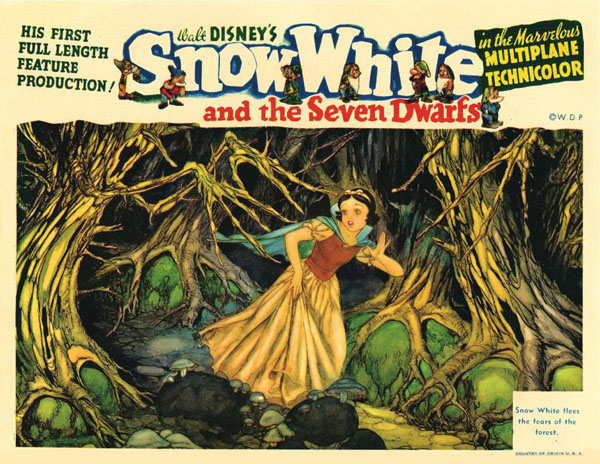
Suspended Animation #282
Hundreds of thousands of artists worked in animation over the decades but very few of their names are known to the people who enjoyed their work.
At the Disney Studios especially during the 1930s and 1940s, artists worked for a brief period of time since it was the only place during the Great Depression where an artist might be able to find paying work.
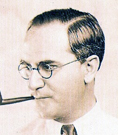
Ferdinand Horvath
Most of the readers of this site can probably easily point to Virgil Partch who among other things did the popular Big George comic strip along with many books of cartoons or Hank Ketchum who did the extremely popular Dennis the Menace or Walt Kelly and Pogo but may be hard pressed to recall some of the other talented artists like Ferdinand Horvath who worked briefly at the Disney Studios.
So who was Ferdinand Horvath?
From the book, Illustrators of Childrens’ Books: 1744-1945 (Mahoney, 1947), Ferdinand Horvath wrote:
“In 1921, I arrived in New York and when my forty dollars was spent I went to work painting window frames on Avenue A, hanging between the eleventh floor and the sidewalk, caulking and painting boat hulls on the Hudson River. After dozens of odd jobs, I went into stage effects, set designing, and finally into animated cartoons.
“In time I did some work for Harper’s Bazaar and other New York publications, and finally found my way into book illustration. In 1933 I joined Walt Disney’s staff in Hollywood and worked with Disney as a sketch artist, idea man, and model creator. After the outbreak of the Second World War, I went to North American Aviation and later to Howard Hughes in a technical capacity to work on confidential designs.”
Ferdinand Horvath, a Hungarian immigrant and book illustrator, was born in 1891 and died of a stroke in 1973. From 1934-1937, he worked at the Disney Studios on everything from advertising to illustrations for a pop-up book to painting backgrounds and doing layouts to constructing three dimensional models (such as making a windmill for study for The Old Mill) to character designs and gags for over fifty Silly Symphonies and Mickey Mouse shorts.
Horvarth was a versatile self taught artist who was often the victim of teasing while he was at Disney for his European looks (where he was thought to look like a character from Dracula) and his quiet, intense, often negative personality. He was apparently still haunted by his near-death experiences during World War I where he spent almost three years in various prison camps.
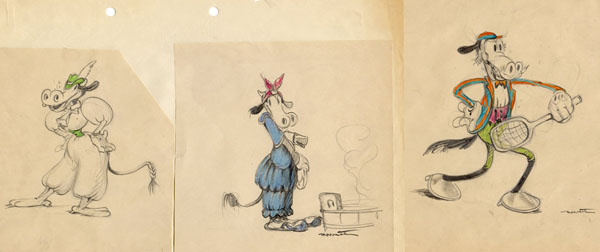
Before working at Disney, he spent six years working at Paul Terry’s “Aesop’s Fables” studio and after he left Disney, he worked for a year (1938-1939) designing models and layouts for Scrappy, Krazy Kat and Color Rhapsodies shorts for Columbia/Screen Gems. In 1940, he sculpted puppets for George Pal’s Puppetoons.
For those more interested in this troubled artist, John Canemaker devoted a chapter to him in his outstanding book, Before the Animation Begins: The Art and Lives of Disney’s Inspirational Sketch Artists (Hyperion Press, November 1996).
After Horvath’s death, Bruce Hamilton was able to acquire from Horvath’s estate a collection of his concept sketches. They were offered for sale in Russ Cochran’s comic art catalog — Graphic Gallery #8 — with fifty pages of art from Snow White, Practical Pig, Brave Little Tailor and many more Disney cartoons including unproduced shorts like Mickey and the Sea Serpent.
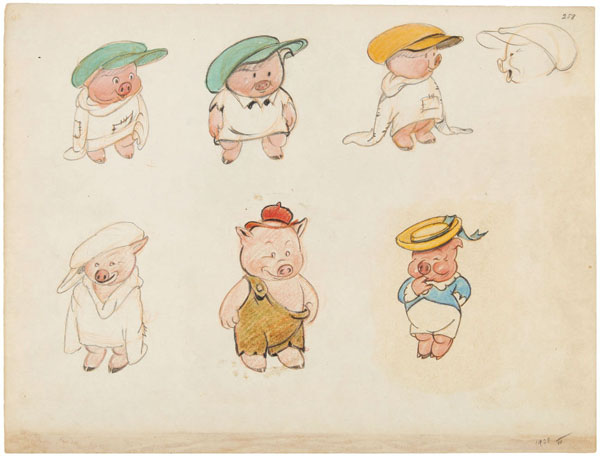
Some of those wonderful historical pieces sold for as little as twenty-five dollars! This is a wonderful collection of Horvath’s work that does not appear anywhere else. Unfortunately only two of the pages are reproduced in color and most animation fans are unaware that this publication even exists since it was a small print run decades ago.
In those days before Disney scholarship, Bruce and Russ struggled to find information about the then unknown artist because of Disney’s decades long policy of not giving credit to artists. Horvath was not credited for his work on Snow White, which may have been one of the reasons he chose to leave the studio.
But his unusual penchant for signing every piece of artwork he did resulted in the Christopher Finch book, The Art of Walt Disney, to showcase lovely colored pencil renderings of the dwarves and Huntsman from Snow White boldly signed by Horvath. That book helped Bruce and Russ validate that Horvarth did indeed do significant developmental work on that particular Disney feature.
At the time, Bruce showed the artwork to Carl Barks who firmly stated that “I consider Horvath to be one of the two finest illustrators to have worked for Disney during the 1930s.”
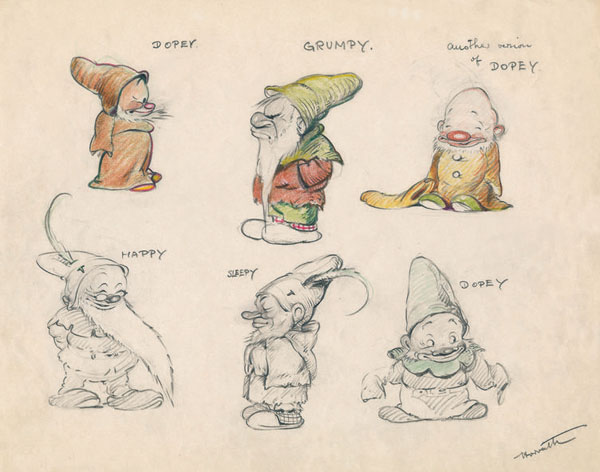
Horvath’s personal notebooks list that he contributed to the following Disney films:
RELEASED:
• MICKEY MOUSE SHORTS: “Mickey’s Man Friday,” “The Band Concert,” “Mickey’s Service Station,” “Mickey’s Garden,” “Mickey’s Circus,” “Mickey’s Rival,” “Moose Hunters,” “Boat Builders,” “Clock Cleaners,” “Brave Little Tailor,” “The Fox Hunt,” “Alpine Climbers,” “Polar Trappers,” “Lonesome Ghosts,” “Mickey’s Trailer,” “Society Dog Show,” “Mickey’s Follies” and “Magician Mickey.”
• SILLY SYMPHONIES: “Father Noah’s Ark,” “Old King Cole,” “Lullaby Land,” “The Pied Piper,” “Cookie Carnival,” “Timid Elmer,” “Three Little Wolves,” “Broken Toys,” “Three Blind Mouseketeers,” “The Country Cousin,” “Woodland Café,” “The Old Mill,” “Little Hiawatha,” “The Moth and the Flame”, “The Worm Turns,” “The Practical Pig,” “Farmyard Symphony,” “Merbabies,” “The Ugly Duckling” and “Mother Goose Goes to Hollywood.”
• OTHER FILMS: “The Hot Chocolate Soldier” (Disney’s special segment for MGM’s 1934 release, “Hollywood Party” ), “Radio City Ballet” CITY (for Radio City Music Hall in New York) & “Snow White and the Seven Dwarfs.”
UNRELEASED: (although some of the ideas and concept sketches may have been incorporated into other films):
• MICKEY MOUSE SHORTS: “Mickey’s Toothache,” “Mickey and the Sea Serpent,” “Mickey’s Barber Shop,” “Stone Age Mickey” (also listed on some of his concept sketches as “Prehistoric Mickey”), “Mickey in the Navy,” “The Legionnaires” and “Mickey in Pygmy Land.
• OTHER FILM PROJECTS: “The Shy Little Bear,”” Ballet des Fleurs,” “Slovenly Peter,” “Reynard the Fox” (which was planned as a feature film and Marc Davis later worked on the project), “The Eskimo Kid,” “The Wise Little Owl,” “Gay Nineties,” “Easter Bunnies,” “Santa Claus,” “Goldilocks and the Three Bears,” “Don Quixote” and “Sinbad the Sailor.”



 Jim Korkis is an internationally respected animation historian who in recent years has devoted his attention to the many worlds of Disney. He was a columnist for a variety of animation magazines. With his former writing partner, John Cawley, he authored several animation related books including The Encyclopedia of Cartoon Superstars, How to Create Animation, Cartoon Confidential and Get Animated’s Animation Art Buyer’s Guide. He taught animation classes at the Disney Institute in Florida as well as instructing classes on acting and animation history for Disney Feature Animation: Florida.
Jim Korkis is an internationally respected animation historian who in recent years has devoted his attention to the many worlds of Disney. He was a columnist for a variety of animation magazines. With his former writing partner, John Cawley, he authored several animation related books including The Encyclopedia of Cartoon Superstars, How to Create Animation, Cartoon Confidential and Get Animated’s Animation Art Buyer’s Guide. He taught animation classes at the Disney Institute in Florida as well as instructing classes on acting and animation history for Disney Feature Animation: Florida.




















































Horvath’s life parallels that of my grandfather, who was also an artist (primarily a portrait painter), spent most of World War I in a Russian POW camp in Siberia, migrated to America in the twenties and lived into the 1970s. So Horvath’s book CAPTURED!, about his experiences in the war, sounds well worth reading.
I don’t know if the error was originally in Horvath’s notebook, but “The Worm Turns” is a Mickey Mouse cartoon, not a Silly Symphony.
“Slovenly Peter”! That was the title of Mark Twain’s translation of “Der Struwwelpeter”, one of the most shockingly gruesome books of children’s verse ever written. The doggerel rhymes describe children who disobey their elders and are horribly killed or mutilated in consequence, with graphic illustrations in full colour. Did someone actually propose to make a cartoon out of this book?
Woah – never knew that. I guess they were going to sanitize the dismemberings. Now Tex Avery could’ve done it bloodlessly and made the body parts all dance around amusingly.
I’d like to see a Scissors Man cartoon.
Not me! Too scary!
I’ve always loved these drawings, since seeing them
In Canemaker’s book. The dwarves look so authentically European, right down to the socks. It would have been a jolt to see Snow White in their company, but I’d love to see them animated. And he’s great with the pencil shading, both color and graphite. Thanks for this!
Another great place to learn more about Horvath is in Didier Ghez’s They Drew As They Pleased Volume 1, as it also has a chapter on him.
I’m in the middle of an investigation about the early cartoonists at Disney. I loved those drawings. Greetings from Guayaquil, Ecuador.
I have an original pencil sketch of his with the signature plink
Any help would be appreciated.
Thanks